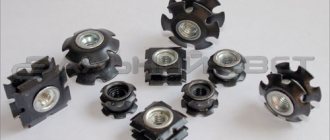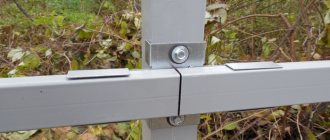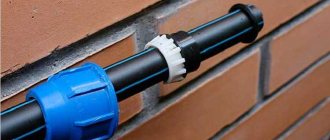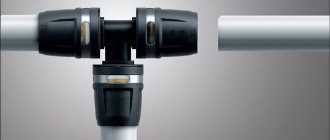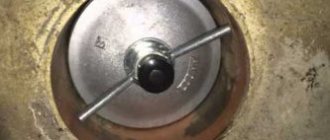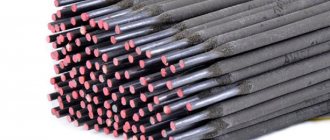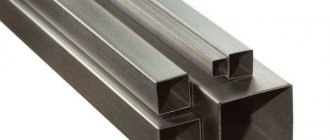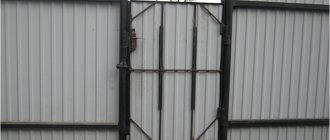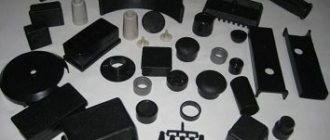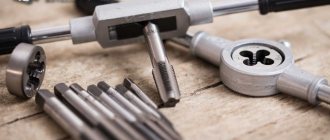When repairing and replacing apartment pipelines, or installing risers, not all connections can be welded. It is impossible to cut threads on a pipe that is close to the wall. For the joint, you will need devices for threadless connection of steel pipes.
Using them, they install main and process pipelines for transporting gas, oil, chemical reagents, and saturated steam. When connecting pipes without welding, the risk of corrosion damage to the joints is eliminated. The metal is protected by tightening linings; they form airtight joints.
Methods for connecting metal pipes without welding
Not all metals are welded well, and sometimes the quality of the seams is poor. Threaded joints are not tight enough, screw threads on metal are destroyed over time.
Weldless connections are technologically advanced. The devices are used on high-pressure gas pipelines when transporting heated media. To install seals, no preliminary preparation of joints or cutting of edges is required. It is enough to clean the ends from dirt and dust.
Methods for connecting metal pipes without welding:
- Clamp tie. A sealed, tight-fitting seal is used to seal leaks. Repairs can be done quickly.
- Flanged. The tightness of the plates is regulated by bolted fasteners, the tightness is ensured by a rubber gasket.
- Installation of the repair mounting clip. The joint is securely fixed in a small metal case.
- Using the Gebo coupling. The compression fitting is suitable for repeated use.
- Fastening fittings without threads. A permanent, hermetic connection of high strength is formed.
- Crab systems. Used for profile rolling.
For threadless connections, no special electrical or gas equipment is required; an installation tool is sufficient. To install the device, no technical training is required.
Video description
Clamping couplings review and comparison.
Compression nut on one side
Such a compression coupling is used to switch to polypropylene or metal plastic Source rozetka.com.ua A similar situation can arise when you need to switch from steel to polypropylene or metal plastic, and this applies not only to bathrooms - the problem can arise both indoors and outdoors. But, for convenience, let’s again take as an example the riser for a heated towel rail, which is either too pressed against the wall, or you do not have the opportunity to use welding. Here, by the way, an additional problem may arise - it will be difficult to get close with a sword-shaped soldering iron, but this is a topic for another article.
In this case, all actions for installing a one-way Gebo fitting are consistent with installing a coupling with two nuts, however, this is already understandable. But, you still have to return to a soldering iron with a sword-shaped tip: when you install the compression device on the pipe, there should be enough space left for the heating part of the tool to reach. If this cannot be achieved, then you will first have to weld the polypropylene elbow onto the coupling, and then mount it on the pipe.
Connection using fittings
Mounting elements used in pipeline assembly vary in type and scope. Types of fittings:
- straight lines are intended for joining two system elements in the same plane;
- adapters are needed when connecting workpieces of different diameters; they are often necessary when repairing old pipelines;
- rotary, allow you to change the direction of flow;
- end caps are necessary when changing the pipeline layout;
- adjustable (tees, crosses) are needed when inserting into main lines or when installing bends;
- fittings – flexible fittings used when connecting to shut-off valves.
For fitting connections without threads, crimp or compression fittings are used. The design includes a sealing ring and is secured with an adjustable clamp. With the help of such fittings it is easy to connect pipes without welding. The joint is tightly and hermetically fixed on both sides. The strength of such a connection is superior to a welding seam. Fittings are used when installing pipes in technological systems where high pressure is created. They are used for plumbing and heating systems installation. No special equipment is required to fix the fittings. They are produced for plastic and metal pipes.
Advantages and disadvantages of collet clamp for pipes
The use of collet-based clamps has gained popularity not so long ago. But now many specialists and professionals widely use this product for various jobs. Unlike a conventional fitting, such a connector has many advantages.
Advantages of a collet connection:
- Affordable price;
- Wide choose;
- Easy installation;
- Durability;
- Connection strength;
- Can be used several times.
The collet itself is inexpensive. In addition, its installation does not require special expensive devices or materials. At the same time, work on replacing the device will also not be very expensive.
There is a wide selection of collets in different sizes on the market. In this case, the product can be purchased at any hardware store or market. Collets are available for various pipes and diameters, so choosing the right product will not be difficult.
To install such fittings you do not need special tools. Anyone can learn to work with a collet in a minimum amount of time. And if installed correctly, the connection will last a long time. At the same time, the collet connection is quite reliable and sealed.
Unlike other connectors, the collet can be used several times. This simplifies pipeline repair work. This way you can only notice a section of the pipeline without dismantling the entire system.
Among the shortcomings of the products, a gradual weakening of the connection is noted. As a result, the pipeline begins to leak. But dealing with this problem is quite simple. You just need to tighten the collet.
But this disadvantage requires that such a connection be installed in an accessible place. You cannot install hidden pipes and hide communications. Lifting work is usually performed once a year.
Using the Gebo coupling
A special compression device will help you connect a metal pipe without welding. The Gebo coupling is a metal flange with a nut, inside of which there are three rings: a cone-shaped clamping ring, a clamping ring, and a sealing ring. To create a strong connection, it is important to adhere to installation technology.
Gebo coupling
The main stages of fastening the coupling:
- Preparation of the ends includes:
— alignment of the cut;
- cleaning of burrs;
— removing a layer of paint or enamel, removing the protective layer from galvanized pipes (the coupling protects the connection from oxidation).
- A nut and a clamping ring are put on one of the workpieces, with the upper part of the cone directed towards the nut.
- The Gebo coupling is assembled: a pressure ring is put on the sealing ring, then a sealing ring, it is turned towards the body, put on another pipe, and inserted into the body.
- The coupling is first compressed until immobile so that the nut does not turn. It is tightened, leaving several turns.
- Check the tightness of the joint. After this, the nut is screwed in completely.
Structure of the Gebo coupling
The coupling body is made of durable stainless steel or non-ferrous metal. The fasteners can be used after dismantling the pipeline; it is enough to replace the sealing rubber ring.
The use of the Gebo coupling is permitted on hot water supply systems. According to standards, the coolant temperature should not exceed +80°C. At high temperatures, the seal will have to be changed.
A few important points when welding
A tool such as a professional soldering iron is expensive. Therefore, it is more profitable to buy inexpensive options if you have to do a one-time job. “Amateur” models are usually equipped with several running attachments. An even better solution would be to rent a tool. The quality of the connections will not be affected in any way.
Before connecting the soldering iron to the network, the parts of the nozzle are placed on the device when it is cold. They begin to work with the tool after the indicators on it go out.
Warm-up time depends on several factors:
- type of pipe products;
- wall thickness;
- diameter of the connected structure.
All of the above parameters, as a rule, are available in the table attached to the soldering irons.
Flange connection
Flanges are a thick disk with a central hole equal to the diameter of the pipe and side holes for bolting. Flanges are installed in areas that need to be inspected periodically:
- when inserting removable plugs, the flange is welded to them at the factory;
- for installation of metering devices (water meters, heat meters);
- installation of shut-off valves (various valves, taps).
Flange connection of metal pipes
A detachable threadless connection of metal pipes is formed by tightly fitting disks onto the edges of the pipes. When the plates are pulled together by a rubber ring gasket, a sealed butt joint is created that can withstand high pressure. The seal between the flanges on water pipes is replaced when leaks occur. When transporting hot or ammonia media (sewage) once every three to five years.
Types and design of shut-off valves
Fittings for plastic water pipes are classified depending on their purpose, design, area of application, operating conditions and method of fastening.
The choice of device is influenced by the material of manufacture - it must be suitable for installation on a specific highway. Depending on the specific application, the following types of fittings are distinguished:
- Constipated. This class of products is the most numerous - it accounts for ¾ of all devices used. Used to completely shut off the flow of media in the line and start it up if necessary. Locking products include gate valves, taps and valves. They are used to regulate the movement of various media - gas, steam, water.
- Regulatory. Devices of this type of shut-off valves for water supply systems have valves and are called liquid, pressure, and medium level regulators. They move due to the operation of an electric drive. One of the common names for such models is throttling valves.
- Safety. Thanks to these devices, communications for various purposes are protected from pressure exceeding permissible values. If this indicator becomes higher than normal, a partial reset of the working environment occurs. Safety valves include bursting discs, bypass valves, and impulse devices.
- Protective. The main importance of such mechanisms is to prevent accidents and breakdowns when technological process parameters are unacceptable for the main line. In addition, the mechanism prevents the flow of the working fluid in the opposite direction. Safety valves include shut-off and check valves.
- Distribution and mixing. It has another name - multi-pass. Such devices include distribution valves and three-way valves. The products are used for mixing media or distributing work flows in several directions.
- Test. Designed to monitor and regulate the liquid level in boilers and vessels.
- Phase separation. Used to separate work environments in different states. Such devices include condensate drains and oil separators.
Flange valves
Based on the connection method, devices are divided according to the following classification:
- Flanged. This type of fittings is presented in round, rectangular and triangular models. Square devices are designed for environments with limited pressure levels - no higher than 2 atmospheres. The round shape is more preferable - its production requires a minimum of resources, and in terms of reliability it is superior to other types.
- Waferless. The range of offered products of this type is quite extensive in terms of methods of connecting it to pipelines, pipes of containers and vessels. Models in this group can be pin-type, fitting-type, welded-type and coupling-type.
Shut-off valves are installed on HDPE, metal-plastic, polypropylene and stainless steel lines.
Installation of repair and mounting clips
Strong non-welding joints are obtained by using special pipe linings that are pulled together. In fact, a repair and installation clip is a type of clamp. It is installed in emergency areas. The peculiarity of this method of threadless connection is its versatility. There are tee clips and crosses. The cast body in the form of two halves of the bushing is easy to install, just put the holder on the pipe, tighten 4 bolts - there are holes for them in the corner lugs. The tightness is ensured by a rubber seal - a piece of hose cut lengthwise.
Repair and installation clip
Clamps are used for process pipelines where leaks need to be quickly eliminated. They can be installed for a long period or until the next repair. Before assembly, the cast body is disassembled to create two halves. Place on the joint or fragment being repaired so that the gaskets fit the pipe tightly. After this, the bolts are inserted into the ears and the nuts are tightened on them. Clips are considered a consumable item by plumbers.
Set of repair and installation clamps for connecting steel pipes
Installation technology
When installing pipes using collet fittings, it is necessary to fix the collet into the inside of the structure. The outer nut is screwed using an adjustable wrench. Thus, an optimal level of structural tightness is achieved. The same actions are performed with the second part of the structure.
It should be remembered that these elements exert considerable pressure on the structure. For this reason, if plastic pipes are installed, the clamping level should be monitored. If excessive force is used, the structure can become severely deformed. For this reason, you must try to regulate your efforts to prevent cracks from occurring in the product. If you would like to learn more about the features of these crimping devices and the specifics of their installation, you can always look at photos on this topic.
Application of clamps
Universal pads are put on cracks to eliminate leaks. They can connect pipes without welding threads. For tightness, sealing gaskets are used. Clamps are made of metal or dense sealed material. In terms of connection strength, clamps are comparable to welding. Overlay designs:
- wide and narrow in the form of split rings with holes for bolts;
- in the form of a metal bracket that secures a sealed gasket;
- complex geometry for fastening to a wall or two pipelines together.
Clamp for fastening metal pipes
Clamps for eliminating leaks are made from scrap materials. Fixed to the pipe with tape or wire.
There are many ways of mechanical connection. You can always choose something suitable for the situation. And the welding machine may not be available during the installation of a pipeline or metal structure.
How gluing is carried out
The connection of galvanized or plastic pipes must be very strong and reliable. To fasten two tubes together, you can use the gluing method. To glue two parts together, you need to carry out the work comprehensively and step by step.
For this you need:
- Apply the adhesive composition with a brush to the inside of the coupling, and then to the tube;
- Mount the coupling to the mark indicating the insertion depth;
- Leave the glue until completely dry.
While the glue hardens, it is forbidden to move or move the elements. It is important to ensure complete peace of mind. The pipeline can be used no earlier than one day after the work is completed. It is worth noting that the reliability and strength of such a connection largely depends on the correct execution of the work.
All materials for gluing pipes are sold in a hardware store
Among the main mistakes are:
- Uneven application of glue;
- Long interval between connecting parts;
- Drying of the adhesive composition ahead of time.
Such a connection can be ideal even for joining square products. In addition, other joining methods can also be used, which may be dismountable or non-dismountable.
Selecting Electrodes
To weld stainless steel with a direct current inverter, it is allowed to use electrodes with a base coating based on calcium and magnesium carbonates. Popular domestic brands include OZL-8 and TsL-11. They are inexpensive, but require experience to operate. The electrodes are prone to sticking and do not hold the arc well, but the seams are obtained with sufficient anti-corrosion characteristics.
The best results are obtained if you choose universal electrodes with rutile coating for your work. They weld common grades of stainless steel using direct and alternating current. The best electrodes are OK 67.60, which are produced by the Swedish company ESAB. They light easily, hold the arc stably, and reduce the amount of molten metal splashes. When working with rutile grades, even a beginner can create a strong seam.
When manual welding, it should be taken into account that the cooling slag begins to spontaneously rebound. Therefore, at this time you need to be located at a safe distance so that it cannot get into your eyes or exposed skin.
